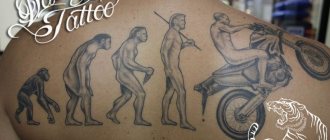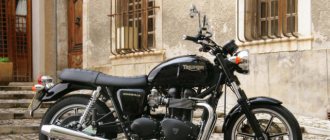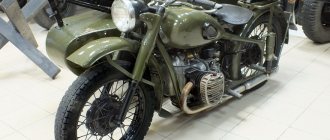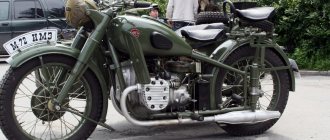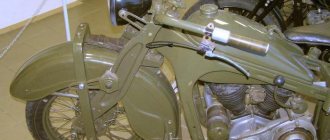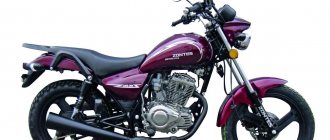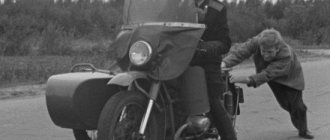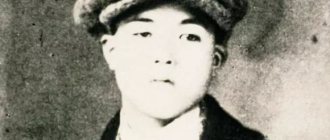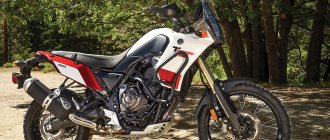History of motorcycle racing
Motorcycle racing began and became popular at a time when motorcycles were just being introduced.
The first cars that were designed for riding appeared at the end of the nineteenth century and were not popular among the population. To prove the advantages of this technology, a competition such as motorcycle racing appeared. In France, the Automobile Club was created, which organized the very first motorcycle races in Paris at the end of the nineteenth century. And after this, this country is considered the center of the world sport of motorcycle racing. It was a rally of all types of cars along an ordinary road over a long distance. All types of motorcycles, even three- and four-wheelers, were allowed to compete.
The crew of the car could tow their vehicle or repair it during the competition. The main requirement was to reach the finish line under our own power. At the beginning of the twentieth century, auto racing and motorcycle racing were officially separated as separate types of competition. MFMC was formed in 1904. And now only this organization held international motorcycle racing.
Competitions held on the road were not interesting to spectators, but they needed to be attracted. To get people interested in racing, competitions began to be held on motorcycle tracks that were created specifically for racing. Each time the competition conditions became more complicated and new tests were added for motorcyclists.
Road racing, which was called road racing, was transformed into another type, road-ring, and it became more spectacular. New requirements and conditions have appeared. It was necessary to climb a hill on a motorcycle, and races were held at record speeds. Speed races are held on special tracks. Racing conditions changed, and, accordingly, new motorcycle designs appeared.
Off-road motorcycle racing also appeared at the beginning of the last century. For the first time, such competitions were held in London. Gradually becoming more and more popular, motorcycle racing began to take place in the form of entertainment shows.
Russia held such competitions for the first time in 1898. This happened near the city of St. Petersburg. And after that, motorcycle races on the Moscow-St. Petersburg road were held constantly. The former Soviet Union also began to hold similar motorcycle races. This happened in 1924. They went to the hippodrome. And when the domestic motor industry began to develop, similar competitions were held in every republic of the Union.
History of MotoGP
Motorcycle racing has always been no less interesting and in demand than car racing. They, too, have gone through a thorny path from a hobby for crazy people to a popular and commercially profitable sports spectacle. The main championship in this high-speed field is the World Motorcycle Road Racing Championship, where the fastest racers on the planet compete on the most advanced two-wheeled equipment. Let's learn more about this wonderful world.
Where did Motorsport begin?
Fast two-wheeled vehicles appeared at about the same time as four-wheeled vehicles. The story began at the end of the 19th century, when the German engineer Gottlieb Deimer made the first prototype, which did not look like a modern motorcycle. Rather, it was a bicycle to which an engine was attached. As the years passed, the invention was improved - the engine became more compact and the wheels shrank to normal size. Despite this, society did not take the new entertainment seriously.
Source: vc.ru
To prove that motorcycles could become a new means of transport, the first races were organized. The initiator of this idea was the Automobile Club of France. Let us remember that thanks to this country cycling appeared and became popular. The debut competition for motorcycles was the Paris-Bordeaux-Paris speed race, which took place in 1895. At that time there were no restrictions on racing vehicles and two-wheeled cars competed with four-wheeled ones. It was only at the beginning of the 20th century that competitions were divided into motorsports and motorsports.
Source: mecum.com
In 1904, the International Motorcycle Federation (FIM) was founded, which until the middle of the last century was called a little differently and was tied to clubs. Subsequently, this organization will become the creator of a new innovative competition - the World Championship in road racing, Moto Grand Prix (MotoGP).
The emergence of road-circuit motorcycle racing
Sports marathons and runs were the only competition in which motorcycles competed. Unfortunately, for the viewer they were boring and dangerous. As a rule, fighting and speed were not shown here; rather, these were competitions of tactics and endurance. It was not the fastest who won, but the smartest and most patient. Moreover, these races took place on ordinary public roads and simply disturbed ordinary passers-by and bothered the city authorities. It was necessary to change the concept that was borrowed from the Tour de France.
An alternative was found quite quickly - the organizers began to use bicycle tracks and hippodromes to hold races. Motorcycle tracks began to be built on the basis of these tracks. Their use had many advantages. Firstly, it was possible to develop amazing speed due to the presence of long and clean straights. Secondly, the small size of the tracks made it possible to reduce the race time and make it more dynamic and interesting. The new concept was to overcome the same route several times. Such races began to be called road-circuit races.
Source: honda-motorcycle2011.blogspot.com
The danger of motorsports has increased several times due to the emergence of a new type of competition. The decisive factor was the increase in the power of the equipment. If the driver made a mistake at high speed, he would have a fatal accident. It cannot be ruled out that the tracks themselves in those days were many times larger and more difficult than they are now. Additionally, there were no safety zones or gravel traps to cushion the rider from being thrown out. To take part in such an event, you had to be either very talented and skilled, or very brave and crazy.
Source: bing.com
Organization of the first World Championship
The French motorcycle club held the first road racing championship in 1905-1906, which was called the “International Cup”. The craziest and fastest people from all over the world were able to take part in it, coming to the competition with their own equipment. After 2 years, the British organized their own race, the “Tourist Trophy”, the main route of which was the famous Isle of Man road . It exists to this day and still hosts prestigious sporting events. This place is the most dangerous and bloody in the history of motorsports - about 150 victims.
Source: blog.moto-centrala.pl
In the first half of the 20th century, many championships and cups took place, and new disciplines also appeared: motocross, freestyle motocross and enduro. All this was spectacular and interesting, but not all the time. At that time, there was no single competition that could bring together all the fastest motorcycle racers in the world, as well as the most famous manufacturers and sponsors. Determining the strongest and fastest was the goal pursued by all the largest motorcycle clubs.
Source: motorsportretro.cm
In 1949, the international organization FIM made the dream come true and organized the first world championship in road racing. It was then decided that the competition would be divided into classes according to the engine power of the motorcycles. This is how championships appeared: 500cc, 350cc, 250cc, 125cc, as well as sidecar racing, 600cc. This was fair, since the pilot’s class came first, and not his motorcycle.
Early seasons and long-term Italian dominance (1949-1965)
On July 17, 1949, the first stage of the newly created World Championship took place. It took place on the famous Isle of Man circuit; the fastest 500cc class was won by Briton Harold Daniell on a Norton motorcycle. Unfortunately, this is the only event for which he will be remembered, unlike the world champion. It will be another Briton, Leslie Graham, at AJC.
Source: fastdates.com
This was a unique first season of the triumph of motorsport in Foggy Albion. Starting next season, only Apennine producers will celebrate. From 1952 to 1974, the fastest class was won by riders who competed on Italian-made motorcycles. In the mid-50s Gilera dominated, and since 1958 MV Agusta. There was simply no intrigue in the championship until the mid-60s. The Italians often won all stages, earning maximum points for the season. Their only rivals were the British Matchless and Norton. Their pilots could win once or twice during the season. They were simply tired of losing year after year. Unable to withstand the competition, these manufacturers gradually began to leave the championship.
Source: yesterdays.nl
The most famous masters of this era were the British: Geoff Duke, Mike Hailwood and John Surtees. The latter has a rather unique achievement. He became a world champion in both motorcycle racing and auto racing (Formula 1). John was very wise and fast, he won through both power and tactics.
The struggle between the Japanese and Italians: the era of “Divine Ago” (1966-1975)
In 1966, two events occurred that changed the balance of power in the championship. Firstly, the famous Japanese brand Honda made its debut in the fastest class. Secondly, the most titled motorcycle racer in history, the Italian, Giacomo Agostini, began his victorious march. The 1966 and 1967 seasons were some of the most interesting in history due to the confrontation between Agostini (MV Agusta) and Halewood (Honda). In both seasons, the fate of the title was decided at the last stage.
In 1966, before the final race in Monza, the Briton was the leader of the championship and had every chance of winning the title in Italy. He won qualifying and started the race as the leader. On lap 6, Mike made a mistake, fell and left the track. His opponent Agostini was able to win both the Grand Prix and his first championship title. Who knows what would have happened if Mike hadn't fallen. It is not the one who is faster who wins, but the one who is more stable.
Source: motociclismo.it
The battle between the two great drivers continued in 1967. Their fight on the Isle of Man became legendary. In this race they were close on every lap and fought passionately. In the heat of this confrontation, Agostini’s technique could not stand it, and he lost, but the battle, not the war. As the season progressed, they exchanged victories and scored approximately the same number of points, however, the Italian was still higher in the overall standings. At the last stage in Canada, Mike won and was equal on points, but it turned out to be useless. Agostini was able to win 2 titles thanks to additional indicators: a greater number of prizes.
Source: newatlas.com
Under the influence of the relative success of Honda, other Japanese manufacturers began to join the championship: Yamaha and Suzuki. As soon as they began to build up their potential, the FIM decided to significantly reduce the teams' resources to increase competition. This change in rules did not please the Japanese, who relied heavily on their rich reserves. They left the championship for the time being, leaving it without intrigue and a dramatic fight for the title.
The great Giacomo Agostini (1968-1975)
15 titles in the two most powerful classes - all this was won by one man, who was nicknamed “Divine Ago”. Having lost his competitors, Agostini single-handedly won the championship for several years. Between 1968 and 1972 he lost only 2 races. All the others were easily conquered by him (49 victories is a fantastic result). For such a long period of victories, Giacomo gains high authority in the world of motorsports. FIM executives very often turned to him for his opinion, relying on his experience and racing wisdom. It was because of his recommendations that the Maine circuit was excluded from the championship calendar in 1976. Agostini lost his close friend Parlotti there and publicly stated that he would never race on the Isle of Man again. Since then, this dangerous track has acquired its own championship and separated from the world motorcycle community.
Source: amcn.com.au
In the early 70s, with the return of Japanese manufacturers, as well as the emergence of talented newcomers to MV Agusta, the victorious march of the “Divine Ago” was interrupted. In 1973-1974, the World Championship was won by the Italian's British partner, Phil Reid. After a slight decline, Giacomo decides to try his hand at a new Yamaha motorcycle. In 1975, thanks to a powerful Japanese stallion, Agostini would win his last career title. In a few years, he will stop racing on two wheels and switch to four. Unfortunately, he was not destined to become a motorsport legend. But he will forever remain one of the greatest motorcycle racers in the entire history of our planet. Modern MotoGP stars will look up to him.
Source: diepresse.com
Japanese Dominance: The Golden Years of Motorcycle Racing (1976-1999)
The fabulous life of Italian manufacturers ended with the departure of Giacomo Agostini. A new time has come - the time to popularize motorcycle racing as a sporting spectacle. The return of the Japanese increased competition in the championship. After the ban on limiting resources, teams began to receive large sums of money to produce equipment. Thanks to this, the power of motorcycles has increased dramatically. The technological race of established brands has allowed many new talented riders to get motorcycles of equal strength. It was then that small companies began to leave the championship. Instead, large manufacturers began to create subsidiary teams, equipping pilots with their own motorcycles. In return, private teams became a testing ground for new developments.
At the end of the 70s, only a few types of racing equipment remained in the championship, the fastest of which were Yamaha and Suzuki. Then Honda joined them and a great Japanese trinity was formed, whose representatives are still fighting for victories in MotoGP. Also at this time, a new generation of athletes appeared who represented exotic countries by the standards of motorcycle racing: Australia and the USA. The geographical map has expanded noticeably; the emergence of new racers from other continents has allowed the championship to expand beyond Europe.
Source: twitter.com
In the 1980s, the most famous high-speed events began to attract public attention. Television, radio and the press began to pay special attention to the World Motorcycle Racing Championship. Unfortunately, such interest has not yet been observed in Russia.
As for the fight for the title, in most seasons it was spectacular and interesting. It is impossible to single out any specific racer, since there were many worthy ones. They mainly represented the USA and Australia: Mick Douhan, Wayne Rainey, Eddie Lawson, Wayne Gardner. European athletes faded into the background and failed to win a title from 1982 to 1999. The Italians and Spaniards, who constantly remained in second place, were especially unlucky.
Source: soymotero.net
It is important to note that the end of the 20th century changed the World Cup and turned it into a mass spectacle. All this was achieved thanks to the arrival of reputable motorcycle manufacturers, the appearance of major television broadcasts of competitions, as well as the birth of a new generation of motorcycle racers. The MotoGP wrapper was created back then. Nowadays, only minor details have changed.
Valentino Rossi era (2000-2009)
At the beginning of the 20th century, a new legend appeared in the world of big-time motorcycle racing. Even now MotoGP is associated with the personality of the Italian, Valentino Rossi. He became Schumacher on two wheels. Over the years, the Italian has acquired enormous authority and the largest army of fans, which supports him even during a career downturn. You could say he became the new incarnation of Agostini. Rossi is second only to him in the number of championship titles, and even ahead of him in the number of victories. During all his performances, Valentino received the honorary nickname “doctor”, thanks to competent tactical calculations and extensive experience.
Photographer: Vyacheslav Larkin (https://www.instagram.com/larkin_photographer/)
The era of its dominance was marked by an increase in motorcycle power to 990cc in 2001. At the same time, the most powerful class of the championship was renamed MotoGP. The “doctor’s” skill level was too great compared to other racers of that time. This was partly due to the fact that controlling the motorcycle had become noticeably more difficult. Like Agostini, Valentino won races and championships with virtually no fight. The speed of Japanese Honda technology made it possible to win by a large margin. At the beginning of the race, thanks to the good reaction and power of the motorcycle, he took 1st place and held it throughout all the laps. Only an unforced error or breakdown could then stop Valentino's victorious march. In this style he won his first titles in the period 2001-2003.
Photographer: Vyacheslav Larkin (https://www.instagram.com/larkin_photographer/)
The lack of intrigue in the championship caused dissatisfaction among many. Detractors claimed that the Italian wins only thanks to his motorcycle, and not his talent. To prove otherwise, Valentino switches to a less powerful Yamaha motorcycle. The lack of competitive technology did not prevent Rossi from once again becoming a triumphant of the season. His advice and comments made it possible to refine technical shortcomings. He made a Yamaha motorcycle as powerful as a Honda. In 2004-2005, the Doctor proved that it was clearly a matter of talent. He became one of the few racers to win the world title using equipment from different manufacturers.
Photographer: Vyacheslav Larkin (https://www.instagram.com/larkin_photographer/)
For 2007, the FIM reduces the power to 800cc, which helps reduce the gap between less skilled riders and real motorcycle racing gurus. Japanese manufacturers have a new competitor from Italy in the person of Dukati. It was their pilot, Australian Casey Stoner, who was able to interrupt thirty years of Japanese hegemony. Valentino Rossi is fading into the background for many reasons. Firstly, tire competition emerged between Michelin and Bridgestone. The second tires were on Dukati and had fewer defects and were also more reliable. Secondly, the decline in motorcycle power has reduced the importance of the pilot's skill. It became easier to control the equipment, which led to the emergence of new competitive racers. Rossi's talent became irrelevant in the late 00s. With experience, he was able to win the last two titles in 2008 and 2009. The era of the “doctor” ended with the end of his youth. Rossi competes in MotoGP to this day, continuing to be the most popular motorcycle racer thanks to his numerous achievements and great skill.
Photographer: Artem Morozov
Modern times: Spanish dominance (2010-present)
After Rossi lost the leading position, the Spaniards began to set the pace for the championship. Jorge Lorenzo was the main star of MotoGP at the beginning of the new decade. Between 2010 and 2012, he won two championship titles and finished second overall once. The Spaniard competed for the Yamaha factory team. Time has shown that it was a single motorcycle rider. Having moved first to Ducati and then to Honda, Jorge stopped showing significant results and left the Grand Prix at the end of the 2021 season.
Source: MotoGP press service
In 2013, Spaniard Marc Marquez didn’t just knock on MotoGP’s door, he literally broke into it. In his first season he became the world champion. He only lost the title once: in 2015. It is not yet known when the second such case will occur. It will be interesting if Mark tries his hand at a new technique. He's been pushing the Honda bike to the limit for too long. A new challenge is needed to consolidate his talent and prove to skeptics that he can become a new legend of the World Cup.
What does a novice viewer need to know about Moto GP ?
About the championship and its participants
MotoGP is a world championship in road racing, which is organized by the large international company FIM. This is the most prestigious competition in motorsport due to the high level of technology and the participation of the largest manufacturers.
In addition to the main MotoGP class (1000 cc), there are two other less powerful classes: Moto2 (600 cc) and Moto3 (250 cc).
The championship motorcycles are a real achievement of technical thought. They are constantly being improved and receiving more and more powerful and efficient new products. You will not find this equipment in stores, it is unique.
Racers of different nationalities take part in the championship. They compete on motorcycles from 6 manufacturers. All these manufacturers create their own teams, whose symbols are worn by the athletes. Only 2 riders can compete in a team at any time.
One constructor can have from 1 to 3 commands. One of them will become a factory one and will receive the largest amount of resources and the latest innovations. The remaining teams will be private, their riders will receive the same equipment as the factory team, but less powerful.
Young athletes mostly start out on private teams. This is very promising, as you can be noticed by the leaders; it is a testing ground for both racers and equipment.
Photographer: Vyacheslav Larkin (https://www.instagram.com/larkin_photographer/)
How is a champion determined?
MotoGP is an annual event that takes place from March to November. It includes 19 stages. At the end of each stage, riders receive points. Whoever scores the most points will become the world champion.
In parallel with the individual competition, two collective competitions are played. The first is the championship of motorcycle manufacturers. At the end of each stage, only one best result of a particular designer is counted. The more motorcycles a manufacturer has, the easier it is for one of them to show a good result.
The second is the team championship. Unlike the previous one, all results are included in the score. It is more objective, since it depends more on the totality of places that riders occupy during the year. A team can only win the title if both drivers consistently produce excellent points. One person cannot win the title for the team.
Source: throttlequest.com
Trails
Each stage is held on special tracks that were built for motorsports and motorsports events. Races take place in 15 countries on 4 continents. Only Spain and Italy organize more than one stage a year.
Source: cyrrider.photos
Stage concept
The World Championship stage is also called the “Grand Prix”, which translates as a big prize. It runs from Friday to Sunday and includes several stages.
On Friday, official training sessions are organized to get the bikes and riders used to the track. Here you can find some problems and try to solve them before the competition starts. Such training is also called free practice; on this day there are 3 sessions, each lasting 45 minutes, during which time you must try to show the best lap time. This is not a contact fight.
Source: MotoGP press service
Saturday is the time for the fourth practice (it is a warm-up, and its results do not play a special role), as well as qualification, which is divided into 2 stages. In the first, those who did not make it into the top ten based on the results of 3 Friday training sessions compete. These drivers are competing to qualify for the final round of qualifying. The holders of the 2 best times, based on the results of 15 minutes, receive this ticket.
The second stage also lasts 15 minutes, here they compete for the best place at the start. The one who shows the best time in the final qualification will be the winner. This triumph is called "pole". Based on the results of the two parts of qualifying, the starting grid is formed. It consists of 8 lines, each of which has 3 racers. The first of them is closest to the start (clean side), the second is in the middle, and the third is farthest from the start (dirty side).
Photographer: Vyacheslav Larkin (https://www.instagram.com/larkin_photographer/)
How the race goes
The main event, the race, takes place on Sunday. In front of it, the teams roll out their motorcycles to the start and begin to prepare them. After all checks, mechanics and engineers leave the track and go to a special area for teams. It's called the paddock. When everyone else has left, the start of the warm-up lap is scheduled. During this lap, racers test the performance of their equipment in practice and also warm up the tires.
After the warm-up lap, the motorcycles line up in order and take their places. The start is given by a special traffic light signal: first the lights come on (get ready), and then go out (start the race). The athletes set off on a journey that will last a little more than 20 laps. The average race time is 45-50 minutes.
This is not Formula 1 and there are no mandatory pit stops (stops to change tires). You can interrupt your race only in forced cases: when you need to replace a motorcycle or install rain tires during wet weather.
The only tactical element in the race is the choice of tires. There are 3 types in total: soft, medium, hard. It is not necessary to wear the same tires on both wheels; there are several combinations of different compounds. The winner is the one who chooses the right type of tire for any specific conditions.
Race results are determined by the order in which the last lap is crossed. The top three winners are awarded after the competition on a special podium. Racers are presented with cups and souvenirs, and at the end they are doused with champagne.
Points are awarded to the best 15 riders according to the system: 25-20-16-13-11-10-9-8-7-6-5-4-3-2-1. These points after the stage are entered into the overall standings table.
Source: MotoGP press service
This is not all that can be said about the most spectacular motorcycle racing on the planet. This championship is wonderful for its intrigue and struggle. Everything we love about racing is here. MotoGP has come a long way to become such a popular competition. He deservedly became one and, of course, is always worthy of your attention.
Author: Vladimir Tumbinsky
Editor: Sofia Hristova
[Total: 2 Average: 3/5]
0
Types of motorcycle racing
Races on sports motorcycles and other types of this equipment are held for each of them separately.
This includes a variety of types of motorcycle racing.
Track tracks are also called speedways.
For such competitions, a variety of surfaces are arranged. For this purpose, ice, earth, grass and other types of coverings are used. Winter motorcycle racing takes place on a track made of ice or frozen ground.
For this type of competition, special sites or natural areas of rough terrain are used. In the classic form of these competitions, the passable route is up to three kilometers long. Stadium cross, or as it is otherwise called, supercross, is held in an open stadium. Dirt motorcycle racing also takes place here.
Supermotos are held only on motorcycles designed specifically for this type of racing. The route is divided into several sections. This is an asphalt road alternating with dirt, where various obstacles are used. The route is no more than two kilometers long.
These races take place over rough terrain. The competition requirements include the following conditions. Pilots must adhere to a schedule that is set in advance. Additional competitions are used during races.
Cross-country and enduro-cross
These are varieties of enduro combined with various types of racing.
Highway-ring
The highway ring is at least three kilometers long. A special feature of these competitions is the many high-speed turns. Here you can use road bikes and special MotoGP classes.
This is the name of road-circuit motorcycle racing designed for endurance. They last for several days, and pilots may change throughout the race.
These are competitions where pilots must show their ability to overcome a variety of obstacles. The entire route is covered in a certain period of time. Special motorcycles participate in the motorcycle trial.
Highway-linear
These races involve road bikes. Regular roads are closed to other vehicles for the duration of the competition.
Here they compete as a team. A motorcyclist must tow a skier along a winter track. It can be snowy or icy. A mixed track is also used. There are restrictions on these races. Do not use wheel chains or studded tires.
Special races where records are set. This can be a record at any distance, short or long. The record can be for maximum speed or minimum time. Or traveling a certain distance in the shortest time.
Stunt Riding
This is motorcycle racing with stunts.
This species appeared in England at the end of the twentieth year. There are a large number of tricks used, and their types vary and become more complicated. These are not all types of motorcycle racing that exist. But the main ones.
But motorcycle racing enthusiasts sometimes organize unofficial and most often illegal motorcycle races around the city. They are also called street racing or street racing. Such races happen spontaneously. But sometimes they are planned and coordinated. Fans of such races are united in special clubs. But there are also opponents of this type of competition, who claim that it is dangerous for other motorists.
There are several types of street racing. Until recently, city racing was prohibited in Russia. They were often carried out on empty roads at night. Conflicts with traffic police officers occurred quite often. But since about 2003, these races have been legalized.
Motoring Championship 2021: motorcycle racing weekend at Igora Drive
On May 29-30, the second stage of the Motoring Championship in road-circuit motorcycle racing will take place at the Igora Drive Autodrome in St. Petersburg. The best Russian pilots will take to the start line to compete for first place in their class.
On Saturday, May 29, training sessions and qualifications will take place, and the three-hour endurance race “Endurance” will start at 17:00.
On May 30, athletes and spectators will enjoy 7 spectacular races in the classes Superstock 1000, Superstock 600, Minimoto, Superbike, Supersport, as well as Road Cup 600/1000. The first race starts at 12:10, immediately after the opening ceremony of the competition. The most anticipated races will be the Supersport and Superbike races, where a spectacular fight for the podium traditionally takes place. After the stage in Grozny, the first three lines of the Supersport category standings belong to Alexey Ivanov, Dmitry Mayorov (both drivers are from the CSKA DMC team) and Vladimir Bolkunov (Full Gazzz). The Superbike class was headed by Makar Yurchenko (SPB Racing Team), second and third positions are occupied by Artem Maraev and Anton Eremin (both pilots from the Motorrika team).
Anton Eremin, Motorrika team driver: “There’s just a little bit left until the second stage. I'm really looking forward to good warm weather and with it great training and racing. The mood for the upcoming weekend is excellent: winter is over, the whole racing season is still ahead. Last year I was able to drive at the Igora Drive circuit three times; I really liked the track: fast, interesting, with elevation changes, and good safety zones. I hope it has been rolled up since last season and tire consumption will be reduced.”
During the break between races, spectators will be able to walk along the pit lane to get a closer look at the motorcycle racing cuisine and chat with top Russian pilots during an autograph session. Also at the stage there will be a live broadcast with live commentary from Evgeny Maslenkov, who is known to many racing fans as the Russian voice of Moto GP.
As part of the second stage of the Championship, a new project, Motoring Racing Academy, a track motorcycle school for novice and advanced amateur pilots, is launching on the Igora Drive track. The Academy box will feature racing Yamaha R1, Yamaha R6 and three Yamaha R3 motorcycles. Instructors will work on the site: Gleb Koltsov, a representative of BMW Motorrad, and Alexey Ivanov, three-time champion of Russia in road racing in the Supersport class.
You can buy tickets for the stage of the Russian Championship “Motoring 2021” at Igora Drive on the spot on the day of the competition or online on the official website of the Autodrom.
Alexander Martsevich, organizer of the Russian Motoring Championship: “The stage at the Igora Drive Autodrom is the most anticipated event in the last six months, the pilots incredibly miss this track. We are the only motorcycle racing series that holds stages there. Last year we managed to gather about 160 pilots at the start, which was a historical maximum for road-circuit motorcycle racing over the past five years. Along with the stage in St. Petersburg, White Nights begin, which promises participants and spectators a long racing day. And it will be incredibly beautiful! We look forward to seeing everyone at our series!”
Motoring is a racing series for road racing motorcycle racing, founded in 2021, organized in accordance with the requirements of modern international standards of road racing motorcycle racing FIM. In 2021, the series takes place as the Russian Championship. The founder is the Motorrika group of companies.
The Motoring Championship in the 2021 season consists of 7 stages, which take place on the best racing tracks in Russia.
Calendar of events: April 17-18 - Fort Grozny May 29-30 - Igora Drive June 12-13 - Kazan Ring June 26-27 - Nizhny Novgorod July 10-11 - Igora Drive August 7-8 - Moscow Raceway September 18-19 - Fort Grozny.
Types of motorsports
Highway-Ring motorcycle racing
In this type of competition, participants compete to cover a certain distance as quickly as possible along a closed asphalt track.
Races can be held on both specially built motorcycles (MotoGP) and road motorcycles of varying degrees of modification (Superbike). Also, races can be held over various distances, from short sprint races to multi-hour endurance races (endurance). Also, races can be held on sections of public roads that are closed to general traffic, forming or not forming a closed route.
In motocross, a closed track has a dirt surface rather than asphalt, often with additional obstacles in the form of natural or specially built slides and jumps.
There are motocross on natural or artificial tracks (Supercross or Supermotocross). Also, recently another type of motorcycle racing, similar to motocross, has become increasingly popular - supermoto, which combines asphalt sections of the track and sections of a regular motocross track.
A flat cinder or ice (occasionally dirt or grass) track in the shape of an oval, short in length (260-400 m, the length of a stadium track), occasionally up to 1 km (hippodrome tracks). Races are held over a distance of several laps (4-6) with a small number of participants (4-6). With a larger number of participants, they are divided into groups and compete within the tournament table, with quarter-finals, semi-finals and a final.
Drag racing
As in car drag racing, motorcyclists cover a certain distance (usually 402 m) in the shortest possible time
The motorcycle trial category includes competitions in passing small but very difficult (and for a regular motorcycle, impossible) distances (sections) with a set of special obstacles. There are motorcycle trials indoors and outdoors.
Wikimedia Foundation. 2010.
See what “Motor racing” is in other dictionaries:
motorcycle racing - motorcycle racing ... Spelling dictionary-reference book
motorcycle racing - rally, race, speedway, bicycle racing Dictionary of Russian synonyms. motorcycle racing noun, number of synonyms: 4 • bicycle racing (4) • ... Dictionary of synonyms
MOTORCYCLE RACING - MOTORCYCLE RACING, nok, unit. a, and, female Motorcycle racing. Ozhegov's explanatory dictionary. S.I. Ozhegov, N.Yu. Shvedova. 1949 1992 ... Ozhegov's Explanatory Dictionary
motorcycle racing - MOTO RACING1, nok, mn (unit motorcycle racing, i, g). A type of motorcycle sport, competitions in motorcycle riding on special tracks, roads (road racing, hippodrome racing, on a green track and off-road). Motorcycle racing in Russia has received as a sport... ... Explanatory Dictionary of Russian Nouns
Motorcycle racing - pl. Motorcycle racing. Ephraim's explanatory dictionary. T. F. Efremova. 2000 ... Modern explanatory dictionary of the Russian language by Efremova
motorcycle racing - motorcycle racing, motorcycle racing, motorcycle racing, motorcycle racing, motorcycle racing, motorcycle racing (Source: “Full accentuated paradigm according to A. A. Zaliznyak”) ... Forms of words
motorcycle racing - motog onki, nok... Russian spelling dictionary
motorcycle racing - plural, R. motogo/nok ... Russian Spelling Dictionary
motorcycle racing - motogo/nki, nok... Together. Apart. Hyphenated.
motorcycle racing - nok, plural (one motogo/nka, i, f.). Sports riding on motorcycles… Ukrainian Tlumachny Dictionary
Why are circuit races needed? At the first stage of motorcycle development, competitions were held in order to quickly see the weak points of the equipment. A few days of racing helped to detect defects that would have come to light years later during normal use. Road racing allowed engineers to improve braking systems, stability, handling and throttle response. Subsequently, experimental methods in laboratory conditions appeared, but motorcycle competitions continued to involve more and more people. Where it all began Road-ring motorcycle racing originated in Europe. In 1902, the Belgian Automobile Club organized a series of circuit races, which gave rise to all subsequent races on a closed road course of limited length with multiple laps. By that time, motorcycles were already participating in speed competitions. Some of the first championships were the “International Cup”, organized by France, and the Tourist Trophy race, organized by England. After the First World War, motorcycle clubs in many European countries organized an annual Grand Prix road race. Since 1949, the FIM has organized the annual world championship in road racing, MotoGP.
MotoGP in the early years
USSR and Russia Motorsports in the USSR did not lag behind the European powers. In the Soviet Union, motorcycle competitions were equal in importance to military training. At that time, motorsports had a high patron - Vasily Stalin, the son of Joseph Stalin, commander of the Air Force of the Moscow Military District and a famous motorcycle lover. He made a great contribution to the development of Soviet motorsports: racing motorcycles were produced on his order, and the power of his powers made it possible to provide spectators for competitions (attendance was mandatory for officers).
Vasily Stalin
The first USSR championship in 1946 was held in the categories: motocross, sprint and linear racing. A year later, the road racing championship was held. It consisted of one stage on the Pirita-Kose-Kloostrimetsa track in Estonia. At the time of the birth of the ShKMG, it was the only track in the country suitable for such competitions. Competitions on the Pirita track
In 1956, another ring highway “Nevskoye Koltso” opened in Leningrad. The first racing competitions there were held as part of the DOSAAF All-Union Motorcycle Racing Championship. At the same time, Soviet athletes began to compete at international championships, and in 1960 the Federation of Auto and Motorsports was created in the USSR. Every year, technical sports gained popularity and became more accessible, technology improved, and the organization of events became more complex. This continued until the collapse of the Soviet Union, along with which all motorsports fell into decline.
Almost a decade passed before our country again took up the development of motorsports. In 1999, the Russian Cup for ShKMG was organized, and in 2000 the Russian Championship itself was born, which is held annually to this day. Since 2011, the Russian Championship has been held by the organizers RSBK (Russian Superbike Championship International CUP or Russian Superbike). RSBK holds international competitions in road-circuit motorcycle racing in two competitions: the Russian Championship and the Russian Superbike itself. The stages officially take place in Russia with the support of the Russian Motorcycle Federation (RMF), under the auspices of the FIM and FIM Europe.
RSBK competitions
Types of motorcycles
Motorcycles are most often classified into types, which are based on the intended purpose of the motorcycle. The classification is not always unambiguous, so different authors may interpret the names differently.
Road
Classic is a motorcycle with a classic layout.
The most versatile motorcycles. Historically preceded all others. Motorcycles of this type provide an upright riding position. There are other names: Streetfighter (“street fighter”), Naked (“naked”, meaning the version without a half-fairing), Neoclassic. A classic motorcycle is a time-tested design and layout, upright riding position and low maintenance, reliability and ease of use. Outwardly, it may look a little like a chopper, but not with such an imposing driver’s position and tons of chrome, or like a sportbike, only with quieter engine characteristics and long, high-torque gears.
Ducati Monster S4
Suzuki Bandit 250-1250
Sportbike - road motorcycles based on models for road racing. They are distinguished by a developed plastic fairing, high-speed engines, landing in a fetal position, high power, controllability and dynamics with a relatively low weight.
Honda CBR600F Hurricane
Kawasaki Ninja ZX-6R
Supersport - more powerful, lighter, controllable and high-speed versions of sportbikes. They often represent the so-called “factory tuning” of sportbikes.
Kawasaki Ninja ZX-6RR
Triumph Daytona 675
Sports tourer - motorcycles intermediate between sports and touring models. They combine the qualities of both classes or offer compromise options.
Tourer - motorcycles designed for traveling long distances. They are distinguished by a comfortable seating position, large-capacity fuel tanks, low-speed engines, and large dimensions. Controllability is sacrificed for comfort. Touring motorcycles have a large amount of additional equipment: air conditioners, radios, airbags.
Harley-Davidson Tour Glide
Honda Gold Wing
Choppers are powerful, heavy motorcycles for leisurely trips around the city. The styling of choppers has remained unchanged since the 1950s. They do not have plastic fairings. They provide a comfortable straight and low “feet first” seating position due to the forward footrests. They are distinguished by low-speed engines and an abundance of shiny chrome parts. They are valued by owners for the opportunity to ride easily and imposingly, observing the surroundings and showing off themselves. Chopper allows you to develop your imagination to the maximum and turn an ordinary motorcycle into a completely personal, sparkling chrome miracle that can make its owner stand out from the crowd and surprise others. The chopper's footpegs are placed forward, the steering wheel is comfortable, and the saddle is two-level. Smooth engine characteristics, thanks to high engine torque, provide a calm and confident ride.
A bobber is a motorcycle that usually has no front fender, the rear fender is shortened, and everything unnecessary is removed to visually lighten the structure.
The predecessors of choppers were serial motorcycles that were converted for street racing - bobber (English bob - short haircut). Unlike bobbers, a chopper not only has all unnecessary parts removed - the front fender, sometimes the front brake, a deep rear fender, but the frame itself is also seriously reworked.
Basic Rules
It is worth noting that road racing requires a high level of organization and large financial investments. That is why this type of competition is practically not developed in Russia. Spain, France, the United Arab Emirates and Australia are considered leaders in this area. These countries have excellent tracks with high-quality surfaces, allowing them to host championships at various levels.
The rules in motorcycle racing are quite simple: riders compete with each other to cover the distance as quickly as possible. Races are held at different distances. There are short - sprint and long - multi-hour motorcycle races, aimed at determining not only the fastest, but also the most enduring motorcycle racer.
In accordance with the championship regulations, only motorcycles of the same class can compete with each other.
At professional championships such as MotoGP, there are 3 classes:
— MotoGP, in which motorcycles up to 1.0 thousand cubic meters participate; — Moto2 class — 0.6 cubic meters. 4 stroke motorcycles; — Moto3 class — 0.25 cubic meters. 4 stroke motorcycles.
The race starts from a standing start. The length of the distance is from 100 to 120 km in sprint. Points are awarded to participants in accordance with the traditional established system. At the end of the race, the motorcycle racer with the maximum number of points is recognized as the winner.


